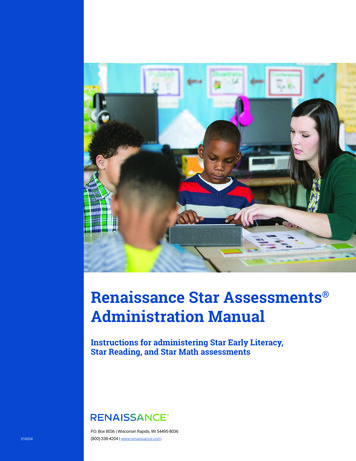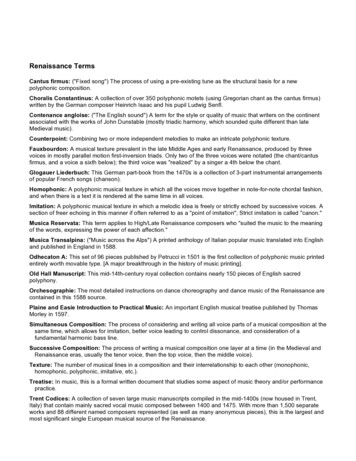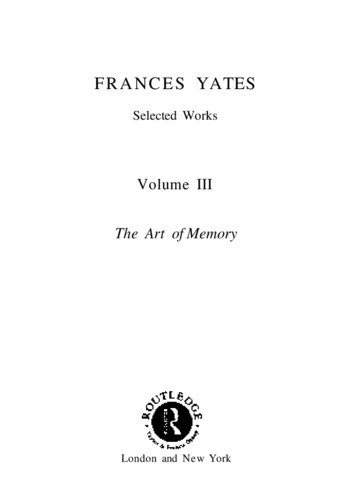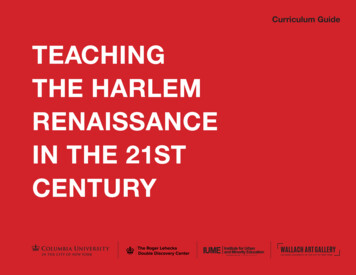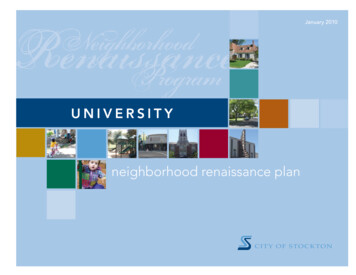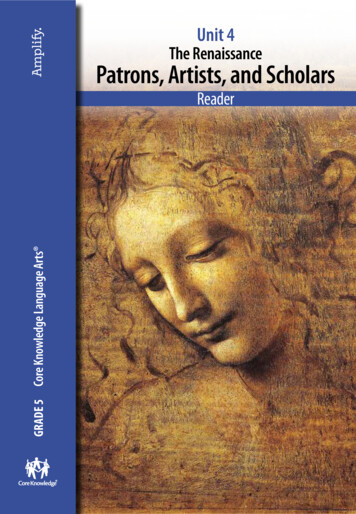
Transcription
Unit 4The RenaissancePatrons, Artists, and ScholarsGrade 5 Core Knowledge Language Arts Reader
Unit 4The RenaissancePatrons, Artists, and ScholarsReaderGRAde 5Core Knowledge Language Arts
Creative Commons LicensingThis work is licensed under a CreativeCommons Attribution-NonCommercialShareAlike 3.0 Unported License.You are free:to Share — to copy, distribute and transmitthe workto Remix — to adapt the workUnder the following conditions:Attribution — You must attribute the workin the following manner:This work is based on an original work ofthe Core Knowledge Foundation madeavailable through licensing under a CreativeCommons Attribution-NonCommercialShareAlike 3.0 Unported License. Thisdoes not in any way imply that the CoreKnowledge Foundation endorses this work.Noncommercial — You may not use thiswork for commercial purposes.Share Alike — If you alter, transform, orbuild upon this work, you may distributethe resulting work only under the same orsimilar license to this one.With the understanding that:For any reuse or distribution, you mustmake clear to others the license terms ofthis work. The best way to do this is with alink to this web .0/ISBN: 978-1-942010-15-9Copyright 2014 Core Knowledge Foundationwww.coreknowledge.orgAll Rights Reserved.Core Knowledge Language Arts is a trademarkof the Core Knowledge Foundation.Trademarks and trade names are shown inthis book strictly for illustrative and educationalpurposes and are the property of theirrespective owners. References herein shouldnot be regarded as affecting the validity of saidtrademarks and trade names.
ContentsThe RenaissancePatrons, Artists, and ScholarsReaderChapter 1: An Italian Rebirth . . . . . . . . . . . . . . . . . . . . . . . . . . . . . . . . . . . . . 2Chapter 2: The Early Renaissance . . . . . . . . . . . . . . . . . . . . . . . . . . . . . . . . . . 12Chapter 3: The Spirit of the Renaissance . . . . . . . . . . . . . . . . . . . . . . . . . . . . . . 20Chapter 4: Michelangelo and Raphael . . . . . . . . . . . . . . . . . . . . . . . . . . . . . . .30Chapter 5: The Bankers Who Loved Art . . . . . . . . . . . . . . . . . . . . . . . . . . . . . . .42Chapter 6: Morals, Modesty, and Manners . . . . . . . . . . . . . . . . . . . . . . . . . . . . .52Chapter 7: Women in the Renaissance . . . . . . . . . . . . . . . . . . . . . . . . . . . . . . . 60Chapter 8: The Northern Renaissance . . . . . . . . . . . . . . . . . . . . . . . . . . . . . . . .68Chapter 9: Popular Prose on Page and Stage . . . . . . . . . . . . . . . . . . . . . . . . . . . .76Selection for EnrichmentMasses, Dances, and Love Songs: Music in the Renaissance . . . . . . . . . . . .88Renaissance Portrait Gallery . . . . . . . . . . . . . . . . . . . . . . . . . . . . . . . . . . . . 94Maps . . . . . . . . . . . . . . . . . . . . . . . . . . . . . . . . . . . . . . . . . . . . . . . . . . . 96Glossary . . . . . . . . . . . . . . . . . . . . . . . . . . . . . . . . . . . . . . . . . . . . . . . . . 99
Chapter 1An ItalianRebirthThe Big QuestionWhat factors inspiredthe Renaissancemovement?Art, literature, and architecture are forms of expression. These forms ofexpression often communicate what is happening during certain periods intime. Have you ever heard the word Renaissance? The word Renaissance means“rebirth” and comes from both the French and Latin languages. This wordRenaissance describes a cultural movement that began in what is now Italyand then spread throughout most of Europe. This was no ordinary change, butrather a revolutionary movement that led to the creation of art, the likes ofwhich the world had never seen before.The Renaissance movement was inspired by a renewed interest inancient Greek and Roman culture and learning. New ideas were born andold ideas were reborn. The Renaissance was a particular period of change,in literature, art, philosophy, science, education, and architecture. Tounderstand why the Renaissance was such an extraordinary movement, ithelps to recall what was happening in Europe before the Renaissance.What Came Before the Renaissance?More than 2,000 years ago, ancient Greece gave us tremendous worksof art and architecture. Ancient Greek sculptures emphasized balance,proportion, and the “perfect” human form. Ancient Greeks built strongbuildings supported by mighty pillars and columns. They gave us the ideasof great philosophers, such as Plato and Aristotle. They gave us lasting worksof literature, including Homer’s Iliad and Odyssey. From ancient Greece wehave inherited important ideas about government, including the idea ofdemocracy—rule by the people. Even the word democracy comes from theGreeks. The Greek word demos means “people.”2
The Colosseum in Rome3
Later, the ancient Romans built upon the ideas and achievements of theGreeks. Like the Greeks, Romans prized sculpture with mythological themes.The Romans also built great structures, such as the Colosseum, and perfectedthe use of the arch and dome. They left us powerful literature such as theAeneid by Virgil. The mighty Roman armies conquered lands and establisheda vast empire.Eventually, different warring tribes invaded the Roman Empire, weakeningRome’s power. These warring tribes sought land. The resulting instability greatlydiminished the influence of ancient Rome. Slowly but surely new culturalgroups, no longer bound by ties to Rome, began to define themselves. The greatRoman Empire declined and was eventually divided in half.Moving OnAcross western Europe, during the time that is considered to bethe start of the Middle Ages, kingdoms and nations began to take shape.Trade, economy, laws, and systems of government were established. Citiesand towns grew. Architectural styles and designs, among other forms ofexpression, became unique to the people of a particular land.While the cultural achievements of the Greeks and Romans were admired,new, home-grown ideas began to thrive. Knowledge of the writings of theancient Greeks and Romans was left in the hands of the few educated elite andin religious houses called monasteries. Some men and women devoted theirlives to the Church. Men called monks lived in monastries. Women called nunslived in convents. The monks made beautiful copies of writings from ancientGreece and Rome. If you wanted to make another copy of a book, you had todo it by hand. There were no printing presses and, of course, no copy machinesor scanners. And so, quietly and in some ways secretly, the monks helped keepclassical learning alive.Passing the TorchMonarchs and the Christian Church established laws and a sense oforder. The Church was a powerful influence throughout western Europeduring the Middle Ages. With its rituals and teachings, the Church was avery important part of the daily lives of medieval people. Everyone from rich4
Chartres Cathedral, Francenoblemen to poor peasants gave money, materials, and sometimes their laborto help build the magnificent churches of the Middle Ages.During the Middle Ages, impressive castles were constructed acrossthe European landscape. Kings battled each other for land, and nations wereborn. People thought a lot about the path to heaven. Art was created to honorGod, or to communicate stories from the Bible, which was important becausefew people were able to read during this time. To express religious devotion,medieval artists created stylized religious figures and moved away from thenatural human form common in ancient Greek and Roman art.But as you know, history does not stand still. Things change and newideas emerge. And so along came the Renaissance movement. But how, andwhy, the Renaissance movement emerged is the question.5
Petrarch and HumanismDuring the 1300s, there was a great Italian poet named Petrarch. Headmired the classical values and teachings of ancient Greece and Rome. Hefilled his library with as many ancient books as he could find. He invitedothers to read and study these books as well.Over the years, more and more people had the opportunity to learnabout the literature, art, and government of ancient Greece and Rome. Thesepeople who admired ancient Greece and Rome were called humanists. Theirintellectual and cultural interest in the art, literature, and government ofancient Greece and Rome was known as humanism.Under the influence ofthe humanists, many artists,philosophers, and scientists studiedthe works produced by the ancientRomans and Greeks. A study of thepast prompted many to examinethe present, and an increasedinterest in certain subjects led toa greater understanding of theworld at large. For example, somescientists such as Copernicus andGalileo looked to the heavens andthe stars. They made astonishingdiscoveries. Others looked tonature and the physical earth.And so the Renaissancemovement was born.Petrarch6
A drawing of theheliocentric systemthat was proposed byCopernicus in which thesun, not Earth, is at thecenter of the solar systemIn particular, breathtakingly beautiful art was produced. Renaissanceartists developed techniques that allowed them to paint the human formin a much more realistic way. Humanists promoted the power and uniquetalents of the individual, both in terms of intellect and ability, but also interms of the human form itself. An Italian architect, Leon Battista Alberti,summed up what you might call a Renaissance motto: “Men can do anythingwith themselves, if they will.” William Shakespeare, the English playwrightwrote, “What a piece of work is a man!” The great minds of the Renaissanceexpanded the themes of their work beyond the Biblical to include those ofhistory, science, and literature. As a result, the people of the Renaissancemade their mark upon the earth.7
The Middle ClassTypically, most people livedand died in the towns and ruralareas where they were born. Ashad been the case for centuries,people belonged to groups, orclasses, and social mobility waslimited.However, during the lateMiddle Ages into the Renaissanceperiod, as the Italians becamewealthier and cities grew, therewere more and more merchantsand craftsmen. There were somany, in fact, that there wasan expansion of the middleclass, the class between thosewho worked the land and thenobility. As a result, the wealthymiddle class grew in power andHans Holbein the Younger’s Portrait of thestatus. Bankers and merchantsMerchant Georg Gisze, 1532 CEproved you didn’t have to be borna nobleman to be rich and powerful. You could work hard and make moneyand rise in society. And with money comes political influence. The rise of themiddle class was not restricted to Italy. The financial and political rise of thissocial group was evident throughout Europe. Without a doubt, the middleclass assumed even greater influence during the Renaissance.Patrons: Dollars for ScholarsSo what do merchants and money have to do with the Renaissance?These wealthy merchants could read and write, although most peoplecould not. As a result, some merchants or businessmen became interestedin literature and art. Of course, most of them were so busy running theirbusinesses that they didn’t have time to write books or paint, but they hadenough money to help others write, study, and create works of art.8
Some of the merchants became patrons of the writers and artists. Forexample, a rich banker might ask an artist to paint portraits of his wife andchildren. The banker would pay for the portraits. In addition, he might providethe artist with food, clothing, and a house while he worked. With the supportof such rich patrons, many artists were able to explore their ideas and developtheir skills. They no longer had to worry about how they were going to eat orwhere they were going to sleep. Later, you will read more about the Medicifamily, one of the most influential banking families and art patrons of all time.And what did thepatrons get out of allthis? What was theirreward for paying artiststo create paintings,statues, books, andbuildings? The patronsbecame famous. Theworks of art theycommissioned signaledtheir power, prestige,and importance. Theywere admired andcelebrated for theworks they paid to havecreated. The artistsand writers also madetheir mark in history.Shakespeare, perhaps thegreatest writer of all, had Giorgio Vasari’s Portrait of Lorenzo de’ Medici, 1533–1544 CEroyal and noble patrons.But it is his name that we remember today.The world was indeed changing. Exquisite works of art were created bypeople so extraordinary that it would be wonderful to have a time machineto take us back in history to meet them. But as we do not, we will just have toturn the pages of this book to learn about them instead!9
The Middle AgesThe Middle Ages had its fair share of troubling times, but it was alsoa time of great achievement in art and learning. Let’s examine some keyachievements.Western EuropeUniversities werefounded in cities such asBologna, Oxford, Paris,and Cambridge. Hundredsof castles, such as Alcázarde Segovia in Spain andDover Castle in England,were constructed in westernEurope. The building ofgreat cathedrals which tookhundreds of years to complete Alcázar de Segovia, Spainwas also undertaken duringthis age.Byzantine CivilizationWhen invading tribesdestroyed and took over much ofthe Western Roman Empire, theEastern Roman Empire, or Byzantinecivilization, remained strong. Thegreat city of Constantinople wasthe center of Byzantine civilization.Constantinople’s central locationmade the city an important linkbetween Europe and Asia. Fromabout 300 to 1453 CE, Byzantinecivilization was one of the mostadvanced in the world.10Hagia Sophia in Turkey was once acathedral. It became a mosque whenConstantinople, now Istanbul, wasconquered by the Ottómen Turks.
Islamic CivilizationDuring the Middle Ages, many Muslim scholars made significantprogress in math, science, and astronomy. Some scholars translated worksby ancient Greek philosophers and scientists into Arabic, which helpedpreserve classical writings. A great thinker and writer named Ibn Sinawrote influential works of philosophy, poetry, and astronomy. He also madeimportant medical discoveries about how to treat diseases.A large part of Spain was conquered and settled by Muslims.Learning thrived in many Islamic cities. Cities such as Palencia, Valladolid,Salamanca, and Alcalá had libraries, schools, and universities. In the 900s,scholars from Africa, Asia, and Europe traveled to Córdoba to be part of acity rich in learning and the arts.Beginning in the late 1000s, Christian forces started to drive theMuslims out of Spain. By the time of the reign of Ferdinand and Isabella—the king and queen who helped finance Columbus’s voyage in 1492 CE—the Muslims had been driven out. They left behind, however, writingsabout science and philosophy that would contribute to the reawakening oflearning in Italy during the Renaissance.The Alhambra in Spain is a magnificent castle and fortress built by the Muslims.11
Chapter 2The EarlyRenaissanceThe Big QuestionWhat are techniquesand features ofRenaissance art andarchitecture?What an exciting time to be alive! Painters, sculptors, architects, andphilosophers were buzzing with ideas. With help from wealthy families and theChurch, they created splendid projects. Let’s meet three important artists from theEarly Renaissance.Brunelleschi LosesBefore Filippo Brunelleschi devoted himself to architecture, he workedas a goldsmith. In 1401 CE, when the city council of Florence invited artists tosubmit ideas for decorating the huge doors of a religious building called theBaptistery, Brunelleschi created a beautiful design.But his design didn’t win. The winning design was submitted by LorenzoGhiberti. When Ghiberti found out that he’d won, he bragged, “I havesurpassed everyone.” The Florence city council offered to allow Brunelleschi towork as Ghiberti’s assistant. But Ghiberti flatly refused his help. This started alifelong rivalry between the men.After losing the contest, Brunelleschi decided to explore his interests inarchitecture. In the spirit of the Renaissance, he looked back to classical times.Brunelleschi WinsAs the years passed, Brunelleschi took what he learned from the ancientRomans and began to develop his own ideas about architecture. Brunelleschi,like other Renaissance artists, began to move away from the complexmedieval style of architecture in favor of the balance and symmetry of ancientGreek and Roman architecture. He had previously traveled to Rome to study12
Cathedral of Florence13
Roman ruins and had been inspired by the dome of the Pantheon. Thisinspiration came in handy when, in 1418 CE, the Guild of Wool Merchants inFlorence announced another competition. They wanted to find someone whocould solve a difficult architectural problem: how to put a roof over a hugespace.The space was over the middle of the cathedral of Florence. Work hadbegun on the cathedral 80 years before Brunelleschi was born, but it stillwasn’t finished. The plans called for a roof to be placed over the middle of thechurch, an area 136 feet wide.For years, the architects of Florence had been arguing about howto build this roof. Some people said it was impossible. But Brunelleschiapproached the Wool Merchants and announced that he could do it. How?He had an idea for how to cover the space with a dome.When the guild members demanded to see his plans, Brunelleschirefused. He claimed they would steal his ideas. To illustrate his point,Brunelleschi brought an egg to a guild meeting. Imagine you are a guildmember at this meeting. You hear Brunelleschi ask, “Can any one of youmake this egg stand on its head without toppling?”No one replies. So, Brunelleschi cracks the egg on the table and balances it onits jagged top. One of your fellow guild members sneers, “We could have done that!”But Brunelleschi responds, “That’s precisely my point. If I tell you myplans to build the dome, you’ll say you knew how to do it all along.”In the end, the guild members chose Brunelleschi to undertake theproject. But then they got cold feet. They thought he needed someone to helphim, so they picked Brunelleschi’s old rival, Ghiberti.Brunelleschi was angry. He knew Ghiberti had no idea how to build thedome. So Brunelleschi pretended to be sick. While he lay in bed, all workstopped. Finally, the guild members told him that Ghiberti could do nothingwithout him. From then on, Brunelleschi alone was in charge.14
Donatello the SculptorThe greatest sculptor of the Early Renaissance was known as Donatello.As a young man, Donatello helped Lorenzo Ghiberti decorate the doors of theBaptistery in Florence. Later, he worked with Ghiberti’s rival, Brunelleschi. Itseems that Donatello and Brunelleschi visited Rometogether to study the ancient ruins.Donatello drew from these experienceswhen he created his well-known sculpture,St. George. On the rectangular base of thestatue, Donatello carved a scene from thepopular legend in which St. George battles adragon. According to the legend, there wasonce a fierce dragon terrorizing a town. Thepeople fed the dragon sheep, but the dragondemanded humans. The unlucky victims werechosen by lottery. When the daughter of theking was chosen, she went to meet her fate.But St. George arrived just in time to save theprincess and slay the dragon. Before leaving thescene, St. George converted all the townspeopleto Christianity.The standing figure of St. Georgethat Donatello carved is a proud andconfident warrior. His strong,muscular form shows throughhis armor. His watchful eyesand his slightly turned stancemake him seem ready forwhatever challenges maycome his way. In this strong, Renaissance sculptors such as Donatello capturedwatchful warrior, the people human emotion in facial expressions and bodypositions that making their pieces highly realistic.of Florence must have seenthe embodiment of theirown spirit.15
A Little BarrelAlessandro di Mariano Filipepi was his real name, but he was calledSandro Botticelli. Botticelli means “little barrel” in Italian. It is believed thatthe nickname was first applied to Botticelli’s older brother, and, when youngSandro went to live with him, people started calling him Botticelli, too. Whilethe nickname doesn’t bring graceful images to mind, Botticelli’s paintings areknown for their grace, elegance, and beauty.Botticelli was born in Florence in 1455 CE. He was first apprenticed to agoldsmith and then later to a famous painter. In 1481 CE he traveled to Rome,where he spent a year painting the walls of the Sistine Chapel. The SistineChapel is located in the Vatican, where the pope, the head of the Church, lives.Botticelli’s most famous painting, The Birth of Venus, shows a scene fromclassical mythology. Botticelli painted Venus in a pose from an ancient Romanstatue, then added his own touches, such as the flowing hair and the almost-sadexpression. The wind gods blow gentle breezes to move the goddess ashore.16
Botticelli was a favorite painter of wealthy patron Lorenzo de’ Medici.Lorenzo and his family were one of the most influential banking familiesand art patrons. They supported artists like Botticelli financially so that theyhad time to create art. In return, the Medici family was admired for theircontributions to the art world. However, Botticelli’s association with theMedici family ended when the family left Florence after Lorenzo’s death.Botticelli lost much of his financial support, too. The monk Savonarola tookcharge of the city of Florence and became the most powerful person in thecity. Savonarola did not approve of paintings like The Birth of Venus.Savonarola’s sermons must have affected Botticelli deeply. He stoppedpainting scenes from classical mythology and turned his attention to religiousthemes. For example, instead of painting Venus, he painted Mary, the motherof Jesus. But he still painted her with grace and elegance.Wind gods (left) blowing the goddess Venus (right) ashore in Botticelli’s The Birth of Venus, 1486 CE17
The Power of PerspectiveThe architect Brunelleschi inspired Renaissance artists when he developedthe mathematical rules for perspective, a way of showing depth on a flat surface.Brunelleschi observed that when we look at things, objects that are close lookbigger, while those that are far away look smaller. He also observed that if youstand between two parallel lines that stretch into the distance, the lines appear tocome closer together until they meet at a point on the horizon. When the linescome together, they seem to vanish, so this point is called the vanishing point.Vanishing point18
These mathematical rules, or instructions on how to achieve a sense ofperspective, were published. Even today, artists used these rules to create asense of depth and space in their work.When applied, these rules are a tool fordirecting the viewer’s eye to the most important subjects of a painting. Thisis in direct contrast to art from earlier times such as the Middle Ages, whendepth and space were not highlighted. The Renaissance painter Raphael, in hispainting The School of Athens, used the structure of the building and the patternof the floor to create a sense of perspective.Vanishing pointRaphael’s The School of Athens, 1510 CE19
Chapter 3The Spirit ofthe RenaissanceThe Big QuestionHow is the spirit ofthe Renaissancerepresented inLeonardoda Vinci’s ideas andaccomplishments?“I don’t know why I let you talk me into this, Master Leonardo!” Carlogrumbled as he dragged an enormous contraption up the steep, rocky hill.Leonardo da Vinci laughed quietly and said, “Here, let me help.” Hesteadied one huge wing of the flying machine as he walked alongside his servant.When they reached the summit, Leonardo gazed down at the streets andbuildings of Florence. “Ah, Carlo, in a few moments, you will be sailing over ourfair city,” he said.“Master,” Carlo sighed, “I wish it were you who could experience thatpleasure.”Leonardo fastened the straps around his servant’s thin shoulders and waist.“Done!” he cried as he tightened the last leather tie.“Master,” Carlo protested, “I look like a giant dragonfly!”“Hush. If this works, your name will be known throughout history,” repliedLeonardo.“If it doesn’t work, I’ll be history!” exclaimed Carlo.Leonardo led Carlo to the edge of a high cliff. Carlo peered over, then madethe sign of the cross.“If you please, Master,” said Carlo, “has it occurred to you that if God hadintended man to fly, He would have given us wings?”20
But Leonardo just smiled and gave Carlo a hearty push off the cliff. AsCarlo plummeted downward, Leonardo shouted, “Man can do anything he setshis mind to do, my faithless friend!”It would be a nice ending to the story if Carlo suddenly swooped upwardand soared like a bird over the rooftops of the city. But, alas, the poor servantfell and broke his leg—or so goes the story that has been handed down to usover the years.The story, whether true or legendary, tells a lot about Leonardo’s attitudetoward life: Man is capable of doing anything he sets his mind to. Anything.That belief drove Leonardo da Vinci to explore uncharted territoryin many fields. He was passionately interested in a number of subjects, andhighly skilled at most anything he tried.21
An Amazing ApprenticeIf we had to pick just one person to represent the spirit of theRenaissance, it might be Leonardo da Vinci. Painter, inventor, scientist,musician, and more, Leonardo embodies the belief that anything is possible.He was born in 1452 CE in Vinci, a town near Florence. As a young boy,he worked as an apprentice to Andrea del Verrocchio, a leading painter andsculptor of Florence. Leonardo’s work as an apprentice kept him busy fromdawn to dusk. He swept floors, fetched supplies, and made brushes. He alsopracticed drawing and painting each day. It didn’t take long for people tonotice Leonardo’s artistic genius.Andrea del Verrocchio, The Baptism of Christ, 1476 CE22
Often, a master artist would paint the main features of a picture butleave it for an apprentice to finish the landscape or other smaller figuresin the background. In 1476 CE, Verrocchio was working on a paintingcalled The Baptism of Christ. Verrocchio painted one angel, and then askedLeonardo to paint another. Legend has it that Leonardo’s angel lookedso much better than Verrocchio’s that the old master never picked up abrush again.Leonardo in MilanWhen Leonardo was about 30 years old, he was invited to work for theDuke of Milan. While he lived in Milan, Leonardo continued to make worksof art, but the Duke also employed him as a military engineer. AlthoughLeonardo called war “beastly madness,” he designed some very dangerousweapons, including an armored cart that resembled a tank.Leonardo’s sketch of armored cartWhen the Duke wanted to impress his fellow noblemen, he askedLeonardo to organize spectacular festivals. Leonardo created fancy stage setsand selected the music. He even designed costumes.While employed by the Duke of Milan, Leonardo constructed a hugemonument made of terra cotta, a clay-like material. The monument was inthe shape of a horse and was to feature the Duke of Milan’s father as the rider.The gigantic clay model was supposed to be cast in bronze, but the Dukewound up using the bronze to make weapons for war. Worse yet, Frenchsoldiers invading Milan used the clay horse for target practice and completelydestroyed it.23
The Painter at WorkIn Milan, Leonardo was kept busy working on all kinds of projects,including designing a whole new plan for the city. But did he ever find time topaint?Yes, indeed he did.While he lived in Milan, Leonardo created one of his greatest paintings,The Last Supper. The painting was commissioned by the Duke of Milan. Itshows Jesus having supper with his closest friends. Some scholars believe,in particular, Leonardo focused on the betrayal of Jesus Christ and the partof the story when Jesus made the shocking announcement, “One of you willbetray me.” Leonardo attempted to capture the very moment when the twelveapostles, Jesus’s closest and most trusted followers, heard those words.How do you paint 13 men at a table and still show all their facialexpressions? Leonardo decided to place the apostles in groups of three, withJesus seated alone in the middle. Notice how the artist isolates the figure ofJudas, the betrayer of Jesus. Judas leans back, away from Jesus.Leonardo paid careful attention to the men’s faces and their gestures,especially their expressive hands. He wandered the streets of Milan searchingfor exactly the right faces and right poses to use as models for the people inthis picture.The Last Supper is painted on the wall of a dining hall in a monastery.While Leonardo worked on the painting, the head of the monastery, calledthe prior, became impatient for him to finish. He complained that Leonardowas lazy, and that the artist was spending too much time wandering thestreets looking for the right face for Judas. Leonardo admitted that it wastaking him a long time to find the right face for Judas. But he said to theprior, “If you’re in a great hurry, then I could always use your face.”It took two years (from 1495-1497 CE) to finish The Last Supper. Thepainting made Leonardo famous throughout Europe. Other artists andengravers made copies of it for hundreds of years.24
25The Bible tells us the story that in the hours before his capture, arrest, and crucifixion, Jesus had supper with his closest friends—hisapostles. One of his friends, Judas, betrayed Jesus. This led to the arrest of
greatest writer of all, had royal and noble patrons. But it is his name that we remember today. The world was indeed changing. Exquisite works of art were created by people so extraordinary that it would be wonderful to have a time machine to take us back in history to meet them. But as we do not, we will just have to






